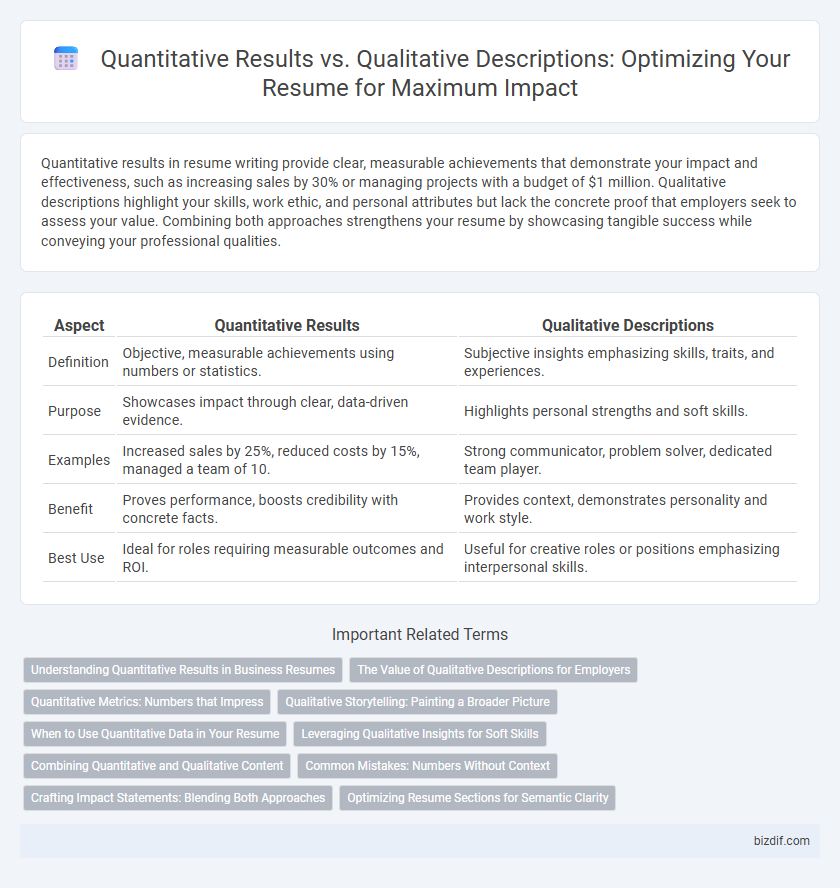Quantitative results in resume writing provide clear, measurable achievements that demonstrate your impact and effectiveness, such as increasing sales by 30% or managing projects with a budget of $1 million. Qualitative descriptions highlight your skills, work ethic, and personal attributes but lack the concrete proof that employers seek to assess your value. Combining both approaches strengthens your resume by showcasing tangible success while conveying your professional qualities.
Table of Comparison
| Aspect | Quantitative Results | Qualitative Descriptions |
|---|---|---|
| Definition | Objective, measurable achievements using numbers or statistics. | Subjective insights emphasizing skills, traits, and experiences. |
| Purpose | Showcases impact through clear, data-driven evidence. | Highlights personal strengths and soft skills. |
| Examples | Increased sales by 25%, reduced costs by 15%, managed a team of 10. | Strong communicator, problem solver, dedicated team player. |
| Benefit | Proves performance, boosts credibility with concrete facts. | Provides context, demonstrates personality and work style. |
| Best Use | Ideal for roles requiring measurable outcomes and ROI. | Useful for creative roles or positions emphasizing interpersonal skills. |
Understanding Quantitative Results in Business Resumes
Understanding quantitative results in business resumes highlights measurable achievements, such as percentage increases in sales, cost savings, or efficiency improvements, that demonstrate tangible impact. Employers prioritize candidates who provide specific metrics, like revenue growth by 15% or customer retention rates rising by 10%, as these indicate clear contributions to company goals. Incorporating precise numbers enhances credibility and helps recruiters quickly assess the candidate's value.
The Value of Qualitative Descriptions for Employers
Qualitative descriptions provide employers with deeper insights into a candidate's soft skills, problem-solving abilities, and cultural fit, which quantitative results alone cannot fully capture. These narratives illustrate how candidates approach challenges, collaborate with teams, and adapt to dynamic work environments, offering a comprehensive understanding beyond mere numbers. Emphasizing qualitative achievements helps employers assess potential impact and alignment with company values, enhancing hiring decisions.
Quantitative Metrics: Numbers that Impress
Quantitative metrics in resume writing provide concrete evidence of achievements, showcasing measurable impact such as "increased sales by 30%" or "managed a budget of $2 million." Numbers offer clear, objective data that capture recruiters' attention and differentiate candidates in competitive job markets. Emphasizing specific figures enhances credibility and highlights a candidate's ability to drive tangible results.
Qualitative Storytelling: Painting a Broader Picture
Qualitative storytelling in resume writing emphasizes illustrating the broader impact of your work by highlighting skills, teamwork, and problem-solving abilities that numbers alone cannot capture. It brings to life your professional journey through detailed narratives that convey adaptability, leadership style, and strategic thinking. This approach complements quantitative results by providing context and deepening the reader's understanding of your unique contributions.
When to Use Quantitative Data in Your Resume
Use quantitative data in your resume when showcasing achievements that can be measured, such as sales growth, project completion rates, or customer acquisition numbers. Quantifiable metrics provide clear evidence of your impact and help hiring managers quickly assess your performance. Incorporating specific numbers like percentages, dollar amounts, or time frames strengthens your credibility and distinguishes your accomplishments from generic descriptions.
Leveraging Qualitative Insights for Soft Skills
Highlighting soft skills through qualitative descriptions enhances a resume by showcasing interpersonal abilities, leadership, and problem-solving talents that numbers alone cannot capture. Leveraging specific examples of team collaboration, conflict resolution, or adaptability provides meaningful context that resonates with hiring managers. Combining these qualitative insights with quantitative achievements creates a comprehensive narrative that effectively demonstrates both technical proficiency and emotional intelligence.
Combining Quantitative and Qualitative Content
Combining quantitative results with qualitative descriptions in resume writing effectively showcases both measurable achievements and the context behind them, creating a compelling narrative. Highlighting specific metrics such as sales growth percentages alongside detailed explanations of strategies employed demonstrates impact and problem-solving skills. This balanced approach enhances credibility and provides recruiters with a clear understanding of both performance and professional strengths.
Common Mistakes: Numbers Without Context
Including numbers without context in resumes often leads to ambiguous achievements that fail to impress recruiters. Employers seek clear explanations of how quantitative results directly impacted project success, revenue growth, or efficiency improvements. Effective resumes quantify accomplishments with specific metrics tied to actionable outcomes, avoiding isolated figures that lack relevance.
Crafting Impact Statements: Blending Both Approaches
Crafting impact statements in resume writing involves blending quantitative results with qualitative descriptions to effectively showcase achievements. Quantitative data, such as percentage increases or revenue generated, provides measurable evidence of success, while qualitative descriptions highlight skills, leadership qualities, and problem-solving abilities. Combining these elements creates compelling statements that demonstrate both performance metrics and personal contributions, enhancing the overall persuasiveness of the resume.
Optimizing Resume Sections for Semantic Clarity
Quantitative results in resume sections, such as "increased sales by 30%" or "managed a budget of $500,000," provide clear, measurable evidence of achievements that enhance semantic clarity and keyword relevance. Qualitative descriptions like "developed innovative strategies" should be optimized by embedding specific outcomes or skills linked to industry terms, improving ATS recognition and recruiter understanding. Combining precise metrics with action-oriented language ensures each resume section communicates value effectively through both data-driven proof and contextual expertise.
Quantitative Results vs Qualitative Descriptions Infographic

 bizdif.com
bizdif.com